| Back to Back Issues Page |
 |
|
Bangkok Travelbug Jan 2021 Ban Khun Phitak Borihan the Green House January 22, 2021 |
| Hello
Phak Hai is one of the 16 districts in Ayutthaya, it's used to be called Kwaeng Sena Yai until 1917 when the name was changed to Phak Hai to avoid confusion with Sena, another district in Ayutthaya. Located at the north-western corner of Ayutthaya Province, it's about 28 km north-west of Ayutthaya City. It's not a place that attracts very many visitors, most of whom will visit the old ruins in Ayutthaya City. The River Noi which branches off from the Chao Phraya 80 km to the north at Chainat flows through Phak Hai. 
The River Noi flowing past Ban Khun Phitak Borihan On the banks of the River Noi in Phak Hai, stands an old wooden house which is estimated to be between 120 - 150 years old. This forlorn, empty two-storey building was home to Khun Phitak Borihan, a nobleman who lived in the reign of King Rama V (1868 – 1910). In fact, King Rama V even spent a night here when he paid a royal visit to Phak Hai. 
View of Ban Phitak Borihan from the River Noi Let's take a closer look at the man who owned this house. Contents About the man Khun Phitak Borihan* was born Phueng Milinthawanit in Ayutthaya City. In the reign of King Rama V, he was the district chief of Sena Yai (Phak Hai today). He was also in the service of King Rama VI (1910 – 1925). 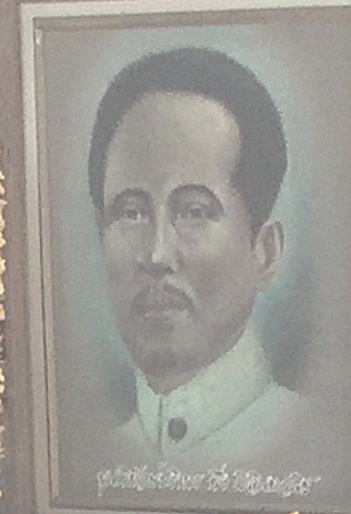
Khun Phitak Borihan *Note: These are royal titles awarded to commoners for good and loyal service to the king. These titles are non-hereditary and only last for the lifetime of the person awarded the title. This practice was abolished after the 1932 coup that changed Thailand from an absolute monarchy to a constitutional one. These titles in descending order of precedence are:
Khun Phitak Borihan ran a boat service consisting of a fleet of 10 big two-storey passenger boats, called Green Boats. These boats plied between Phak Hai and Tha Tien in Bangkok where Wat Pho is located. There was also another service route between Phak Hai and Pak Nam Pho in Nakhon Sawan, 250 north of Bangkok where the Rivers Ping and Nan merge to form the Chao Phraya River. These boat service brought passengers and vendors to the local markets and helped the local economies prosper. The advent of sluice gates for water control, roads and motor vehicles brought an end to this boat service. Khun Phitak came from a big family with six siblings, two of his grand-daughters aged 78 and 80 are still living today in Lat Phrao Bangkok. His wife Nong Jang Milinthawanit was a native of Phak Hai. When he was very old and unwell, Khun Phitak took a boat downriver to seek medical attention in Bangkok. He didn't return to his house again, he died on his way back. After Khun Phitak passed away, his children and grandchildren moved out of the house, most of them settled in Bangkok. Nang Jang, Khun Phitak's wife used to come back to see the house once a year when she visited her relatives in Ayutthaya. In later years, she stopped her visits. In 1962, Nang Jang donated the house to the Treasury Department. 
Ban Khun Phitak Borihan viewed from the carpark Contents About the house Ban Khun Phitak Borihan is built on a land area of 1 rai** and 72 sq. wa** which is equivalent to 1600+288 sq. m or 1,888 sq. m or 20,322 sq. ft. The house is a two-storey traditional Thai teak house that's raised off the ground. It has with some concrete parts. **Note 1 rai a Thai unit of measuring area equals 1600 sq. m or 17,222 sq. feet. 1 wa, an old measure of length equals 2 m, therefore 1 sq. wa equals 4 sq. m. There's a shrine outside the house dedicated to Khun Phitak Borihan. Visitors to the house pray at the shrine before entering the house. 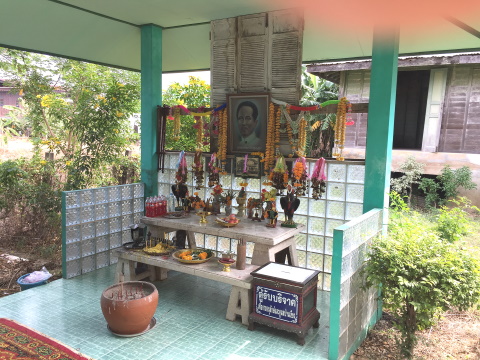
Shrine dedicated to Khun Phitak Borihan The house has a hip roof, that is a roof with sides that slope towards the walls of house leaving no room for gables. Hip roofs are more stable structures, suitable for areas with strong winds. 
Note the roof of the house which extends to the sides of the walls Gable roofs on the other hand slope on two sides forming triangles at both ends which are filled with triangular walls called gables. Such roofs are not suitable in areas with very strong winds. Ban Khun Phitak Borihan has a green exterior and dark brown roof tiles, as Khun Phitak Borihan was born on Wednesday and adopted green as his personal colour. As a result, villagers in the area called the place the Green House. Visitors will approach the house on the landward side where there is ample parking. Wooden stairs lead up to the house. Please remove your footwear before entering. 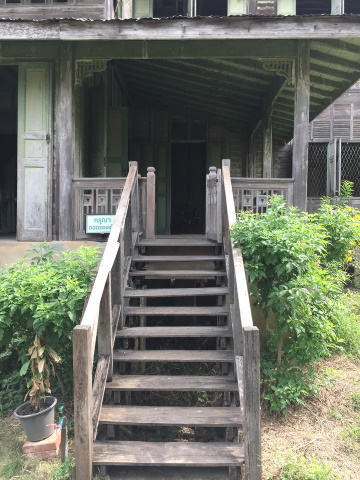
Stairs leading up to the house The condition inside the house is reasonably good. However, the exterior is dilapidated and efforts should be made to preserve the house to prevent further deterioration. The layout of the house consists of a big hall with 3 teak cupboards downstairs and two smaller rooms. The smaller room to the rear has a safe that is still locked! A small storeroom is located below the stairs. 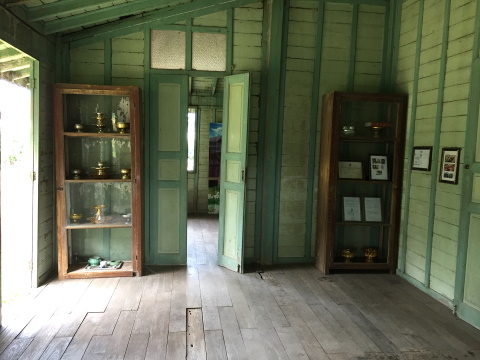
The hall downstairs 
Altar in one of the smaller rooms downstairs There are some unusual items in the house which you will not see today. 
An old safe that is 1 m high, imported from Hamburg, Germany 
Grandfather's clock 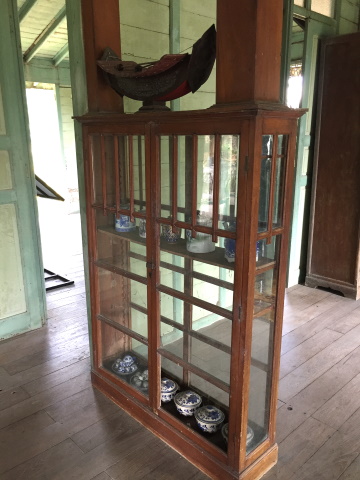
Showcase that can be dismantled to individual pieces held together by wooden joints, no nails are used 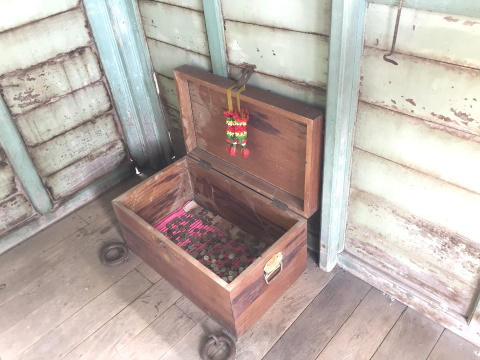
Treasure box for keeping valuables – in Thai it's called box for silver and gold 
Staircase leading upstairs Upstairs, there's a big hall and three bedrooms rooms. The hall upstairs opens up into a tiled balcony that overlooks the river. The floor and stairs inside are made of teak. 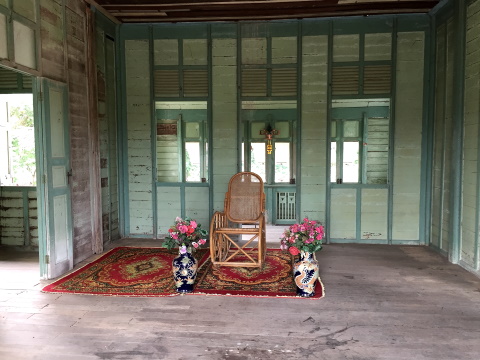
The hall upstairs 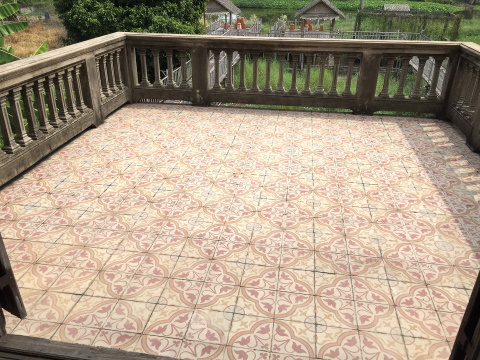
The tiled balcony overlooking the River Noi, the tiles were imported from Europe and have proven to be very durable The doors and windows in this old house, like some of the items in the house, are also rarities. 
Pressing the handle in the centre will drive the top half of the long metal bolt up and the lower half down into small wells thus locking the door 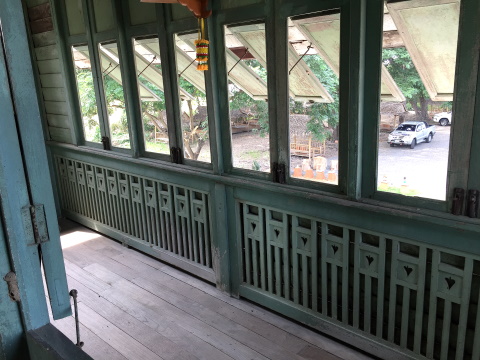
Swing windows to the rear of the hall upstairs overlooking the carpark Two wooden walkways lead out from the house towards a sala by the River Noi. Please note that in those days there were no roads and people travelled by boat along the waterways. For this reason, the front of the house faced the river. 
The two wooden walkways leading from the house to the sala and the river One of the walkways has completely collapsed and is impassable. The other has wooden planks placed over the broken walkways. Please be careful when walking here. 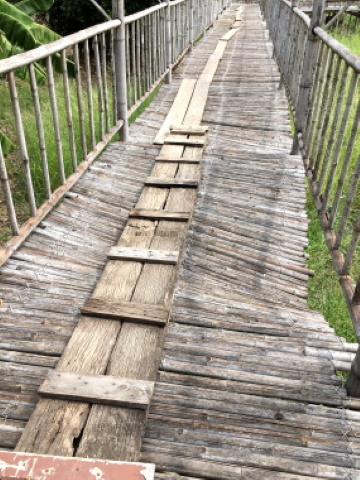
The wooden walkway on the left that is still passable There's also a hut where the caretaker used to live but since he has passed away nobody looks after the house. 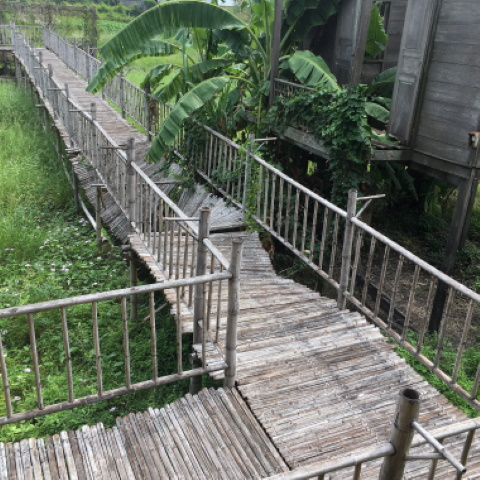
The walkway on the right has collapsed completely, the hut to the right appears to be the caretaker's hut 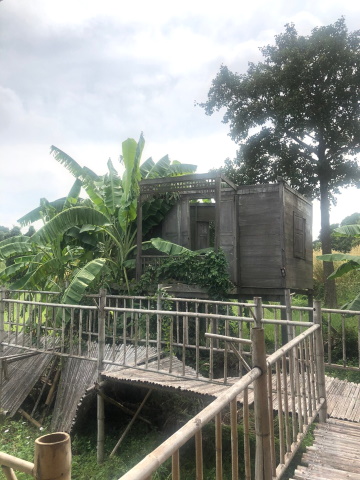
This view shows the collapsed walkway and the empty hut Nai Meng 83, a food vendor recalls that as a boy of 10 he used to paddle his boat past the house to sell his wares. He recalls the house bustling with many servants and occupants. 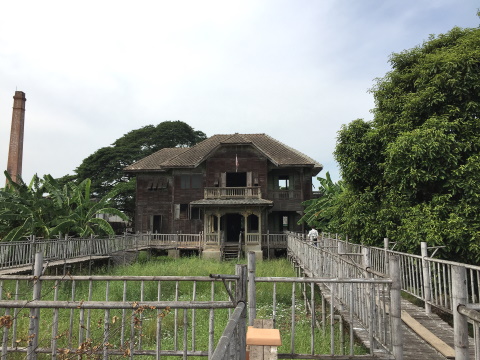
View of the house from the river, a far cry from the old days Doctor Tanai Milinthawanit, a great-grandson of Khun Phitak Borihan recalls that the royal chronicles record King Rama V's visit to the area along the River Noi when the king expressed a desire to reside in this house for the night. Khun Phitak Borihan and his wife Nang Jang was then accorded the honour of hosting the royal visitor. This room upstairs where these photos are hung was probably the room where King Rama V spent the night. 
Popular photo of King Rama V smoking his pipe in Dusit Garden 
The king in his ceremonial uniform Nai Chaikorn who lived in the house across the river from Ban Khun Phitak Borihan recalls his mother telling him that Khun Phitak Borihan was a highly respected person in the community. He organised thod krathin ceremonies to offer new robes to the monks after the Buddhist Lent and the annual boat races in the 12th Thai lunar month (sometime in October). Contents Is the house haunted? Recently two Thai television channels and a newspaper have presented documentaries and articles speculating the Ban Khun Phitak Borihan is haunted by ghosts and spirits. But relatives and descendants of Khun Phitak have dismissed these reports as baseless. They maintained that nobody has died in that house. Besides Khun Phitak was a good man who always performing good deeds for the community. There is no reason for spirits to haunt the house. An old empty house in an isolated stretch of countryside invariably sparks the imagination for spooky tales. Whatever the case, that humble old house with fading green paint on the banks of the River Noi, holds the singular honour of hosting a king for the night. 
A silent witness to a bygone age Contents Attractions in Phak Hai While you are in Phak Hai District, the Lat Chado Community which is about 6 km west of Ban Khun Phitak Borihan is an interesting place to drop in for a visit. The annual Khao Phansa Boat Procession is a beautiful and colourful festival in the Lat Chado Community that takes place at the start of the Buddhist Lent. Contents Map to Ban Khun Phitak Borihan If the map doesn’t appear, click on this link Address Ban Khun Phitak Borihan Mu 2 Tambon Amarit Amphur Phak Hai Phra Nakhon Si Ayutthaya Contact: Khun Praman Suebmongkol Tel: 081 780 8537 How to get to there From Bangkok take highway 1 – highway 32 – past Ayutthaya - turn left to route 33 past the Pa Mok junction – turn left into route 3454 – turn left into soi leading to Wat Amarit Sittharam – turn left again to Ban Khun Phithak Borihan. Opening times Ban Phitak Borihan is open every day from 0900 – 1600 hours Contents Next month In view of the prevailing pandemic, we will refrain from travelling to other provinces. Luckily, we just noticed an attraction right in our district to present to you. Suan Sam Phran See you then. If you enjoyed reading this e-zine, please forward it to a friend. If you received this from a friend and found it interesting, please subscribe at Bangkok Travelbug. What do you think of the Bangkok Travelbug? We love to hear from you What other subscribers have said Till next month then. Eric Lim Tour Bangkok Legacies Find us on Facebook My Journey through Thailand Part I The First Steps This is my second e-book and the first in the series of travel journals on my trips to explore the various provinces in Thailand. This edition, which covers my travels from late 2009 to mid-2013, will guide you to historical sites, cultural monuments and exquisite Thai handicraft, across a vast spectrum of cultural and ethnic diversity. You can have a virtual tour with this e-guide book or take the first steps yourself in this journey through Thailand. My Kindle e-book 
Copyright@2008-2021 Tour Bangkok Legacies All rights reserved |
| Back to Back Issues Page |

